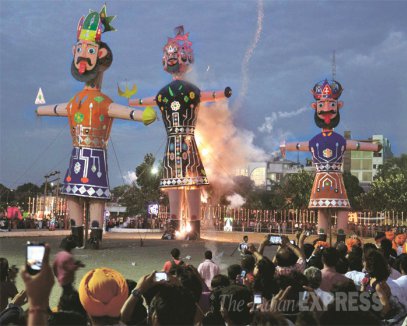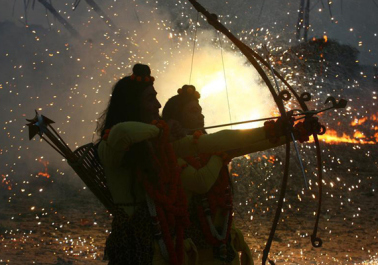Dussehra, also known as Vijayadashami, is one of the most important Hindu festivals celebrated in various forms, across India, Nepal, Sri Lanka, and Bangladesh. The name Dussehra is derived from Sanskrit. Dasha-hara literally means Dashanan ravan (the name of Ravan and in short Dasha and Hara (defeat)) referring to Lord Rama‘s victory over the ten-headed demon king Ravana.
The day also marks the victory of Goddess Durga over the demon Mahishasur. The name Dussehra is also derived from Sanskrit Ahaha, which means day. For example, Aharnisha is derived from Ahaha+nisha. The Goddess fought with evils for nine nights and ten days. The name Vijayadashami is also derived from the Sanskrit words “Vijaya-dashami”, literally meaning the victory on the dashami (Dashmi being the tenth lunar day of the Hindu calendar month). Diwali, the Festival of Lights, is celebrated twenty days after Dussehra.

In India and Nepal, the harvest season begins at this time and so the Mother Goddess is invoked to start the new harvest season and reactivate the vigor and fertility of the soil. This is done through religious performances and rituals which are thought to invoke cosmic forces that rejuvenate the soil. Many people of the Hindu faith observe through social gatherings and food offerings to the gods at home and in temples throughout India and Nepal.

Rama had performed “Chandi Homa” and invoked the blessings of Durga, who blessed Rama with secret knowledge of the way to kill Ravana. On the day of Ashvin Shukla Dashami, Rama defeated Ravana and rescued Sita. Thus it is termed as Vijaya Dashami. Based on the inferences from Valmiki’s Ramayana, Kalidas’s Raghuvamsa, Tulsidas’s Ram Charit Manas, and Keshavdas’s Ram Chandra Yas Chandrika as well as common perception in India, Rama, Sita, and Lakshmana returned to Ayodhya on the 30th day of Ashwin (19–20 days after Vijayadashmi). To mark the return of Lord Rama, in the evening, the residents of Ayodhya lit their city with millions of earthen lamps (called Deepak). Since then, this day is celebrated in India as Deepawali or Diwali.
Many people perform “Aditya Homa” as a “Shanti Yagna” and recite Sundara Kanda of Srimad Ramayana for 5 days. These Yagna performances are thought to create powerful agents in the atmosphere surrounding the house that will keep the household environment clean and healthy.
Some householders perform Yagnas thrice daily along with Sandhya Vandana, which is also called Aahavaneeya Agni, Grahapatya Agni or Dakshina Agni. In addition, the Aditya Homa is performed with the Maha Surya Mantras and the Aruna Prapathaka of the Yajurveda. These mantras are believed to keep the heart, brain and digestive functions in balance in the absence of adequate sunlight in the winter months.
The day also marks the victory of Goddess Durga over the demon Mahishasur. The name Dussehra is also derived from Sanskrit Ahaha, which means day. For example, Aharnisha is derived from Ahaha+nisha. The Goddess fought with evils for nine nights and ten days. The name Vijayadashami is also derived from the Sanskrit words “Vijaya-dashami”, literally meaning the victory on the dashami (Dashmi being the tenth lunar day of the Hindu calendar month). Diwali, the Festival of Lights, is celebrated twenty days after Dussehra.

Significance of Dussehra:
Vijayadashami is celebrated on the tenth day of the month of Ashwin according to the Hindu lunisolar calendar which corresponds to September or October of the Gregorian calendar. The first nine days are celebrated as Maha Navratri(Devnagari: नवरात्रि, ‘nine nights’) or Sharada Navratri (the most important Navratri) and culminates on the tenth day as Dussehra.In India and Nepal, the harvest season begins at this time and so the Mother Goddess is invoked to start the new harvest season and reactivate the vigor and fertility of the soil. This is done through religious performances and rituals which are thought to invoke cosmic forces that rejuvenate the soil. Many people of the Hindu faith observe through social gatherings and food offerings to the gods at home and in temples throughout India and Nepal.

Victory of Lord Rama over Ravana:
As per Hindu religion, on this day in the Treta Yug, King Rama, also called Shri Ram, the seventh avatar of Vishnu, killed Ravana who had abducted Rama’s wife Sita to his kingdom of Lanka. Rama, his brother Lakshmana, their follower Hanuman and an army fought a great battle to rescue Sita. The entire narrative is recorded in the epic Ramayana, a Hindu scripture.Rama had performed “Chandi Homa” and invoked the blessings of Durga, who blessed Rama with secret knowledge of the way to kill Ravana. On the day of Ashvin Shukla Dashami, Rama defeated Ravana and rescued Sita. Thus it is termed as Vijaya Dashami. Based on the inferences from Valmiki’s Ramayana, Kalidas’s Raghuvamsa, Tulsidas’s Ram Charit Manas, and Keshavdas’s Ram Chandra Yas Chandrika as well as common perception in India, Rama, Sita, and Lakshmana returned to Ayodhya on the 30th day of Ashwin (19–20 days after Vijayadashmi). To mark the return of Lord Rama, in the evening, the residents of Ayodhya lit their city with millions of earthen lamps (called Deepak). Since then, this day is celebrated in India as Deepawali or Diwali.
Many people perform “Aditya Homa” as a “Shanti Yagna” and recite Sundara Kanda of Srimad Ramayana for 5 days. These Yagna performances are thought to create powerful agents in the atmosphere surrounding the house that will keep the household environment clean and healthy.
Some householders perform Yagnas thrice daily along with Sandhya Vandana, which is also called Aahavaneeya Agni, Grahapatya Agni or Dakshina Agni. In addition, the Aditya Homa is performed with the Maha Surya Mantras and the Aruna Prapathaka of the Yajurveda. These mantras are believed to keep the heart, brain and digestive functions in balance in the absence of adequate sunlight in the winter months.
Dussehra is celebrated in every part of India
-
Southern India:
-
In Southern India:
-
In Western India:
-
In Eastern India:
















0 comments:
Post a Comment